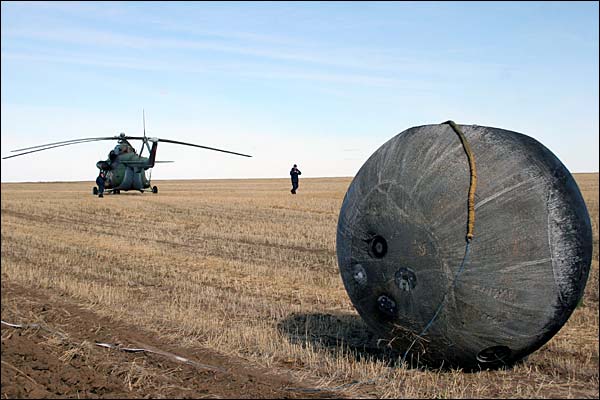[/caption]In an effort to understand how organic chemicals might survive after a period in the vacuum of space and then violent re-entry through the atmosphere, scientists have uncovered some interesting results. Last year, the ESA/Russian Foton-M3 mission was launched to test the effects of microgravity on various biological samples. However, a sample of Orkney rock had a harder journey than most. Attached to the outside of the craft, this sample underwent extreme heating during the descent toward the plains of Kazakhstan. Although most of the sample was vaporized, scientists have unveiled results that the sample still contains very obvious signs that it once harboured life. These exciting results set new limits on how organic chemicals may survive unaltered for long periods in space before plunging through a planetary atmosphere, plus it raises some interesting questions into how future searches for extraterrestrial life may be performed…
The principal mission objective for many planetary missions is the search for extraterrestrial life. Although many of our robotic explorers cannot detect life directly, they are able to carry out a host of mini lab experiments on samples taken from the planets surface. NASA’s Phoenix Mars Mission for example has been tirelessly slaving over its hot oven (a.k.a. the Thermal and Evolved-Gas Analyzer, or TEGA for short), dropping samples of Mars soil into its single-use kilns for the last few months. This effort is to vent any prebiotic chemicals into a gas form so instrumentation can then “sniff” the vapour. Should organic chemicals be found, there will be an improved chance that life may have evolved on the Red Planet’s surface.
But say if there is an easier (and cheaper) way to look for ET? Rather than sending hundreds of millions of dollars-worth of hardware to Mars to look for organic chemicals, why can’t we analyse all the rocky samples littered across the globe that originated from space? After all, we now know that some meteorites originate from Mars itself, surely we can perform a far more detailed analysis on these samples instead of depending on a robot millions of miles away?
The big stumbling block comes if we consider the extreme temperatures meteorites are put under during re-entry into the terrestrial atmosphere. Generally one would expect any evidence for past life (whether that be organic chemicals or fossilized remains) to be blow-torched out of existence by reentry temperatures up to 3,000°F (1,650°C). So, researchers from the University of Aberdeen, Scotland, decided to test a chunk of rock from a Scottish island by subjecting it to several days in space and then seeing if any evidence of life in the rock sample remained intact after the descent.

“The specially prepared piece of Orkney rock took part in the unmanned Foton M3 mission which aimed to examine the rock’s behaviour when it was exposed to the extreme temperatures involved in it’s re-entry through the Earth’s atmosphere,” Professor John Parnell, lead scientist in the study, said.
The reason why Orkney rock was used is because of the material’s robustness when exposed to extreme heat. After all, meteorites need to be made of tough stuff to make it to the ground. “Three quarters of the rock, which was about the size of a small pork pie, was burnt off in the experiment. However, the quarter which returned to Earth has shown us that if intelligent life were to have come into contact with the rock, it would have provided them with evidence that life exists on another planet.”
Now this is where the implications behind these results become abundantly clear. If this piece of rock was sent out into space, only for it to eventually encounter an alien world with intelligent life on its surface, it is conceivable that the rock would survive reentry, preserving the organic chemicals for further study by extraterrestrials. Of course, the reverse is true. If life existed (or exists) on Mars, perhaps we should take a closer look at those Martian meteorite samples…
In the case of the Orkney sample, it contains the remains of 400 million year-old algae, providing a rich chemical signature that Parnell and his team could detect. “We would be extremely excited if we found similar remains in a meteorite arriving from another world,” he added.
Although this experiment only scratches the surface of how organic chemicals may last, unaltered, in space (after all, should a meteoroid sample float in space for millions of years, could organic chemicals be altered by cosmic rays?), it does help us understand that for lower energy reentries, organic chemicals can indeed survive the burn…
If this is the case, let’s sit back and wait for the next meteorite to land (this sounds like another novel approach for WETI!).
Original source: Physorg.com


May be they have connected with earth but we can’t aware about their presence!
Yeah. The difficulty is to sort out which is alien and which is contaminated by terrestrial. However your argument has some holes. Would it not be best to plan to search for alien life among the lunar rocks which have not been possibly contaminated by terrestrial organisms? Antarctica would actually be the best place on earth because it would lessen the chance of contamination. Also
searches would extreme quarantine procedures.
The article also shows the limitations of using organic chemistry. Most of organic molecules are easily destroyed by temperatures. Importantly, the amino acids used to create DNA life forms are destroyed around 300°C – let alone 1,650°C. Survival of such molecules would be soon be gone on re-entry. The only chance would be if it were encased inside the rock.
I also think that identifying organic molecules is fine (even if it is carbonised soot) but what is more difficult is proving that these organic molecules were once organised into some living and breathing minute life-form.
If they want to do an experiment on organic molecules facing re-entry, perhaps they should just attempt this with various bottles of shampoo. Shampoos have more organic molecules in their solutions than any other known material on earth! Just coat the re-entry on some spacecraft and see what remains!
Furthermore, this premise is also the storyline of the 70s movie, Andromeda Strain.
Good to see an old Vostock derived vehicle still in use after all these decades…
this has been a concept in sci fi for decades
Nifty, but I’m not altogether happy with the same team selecting and analysing the sample. After all they knew what they were looking for.
A double-blind follow-up would nice. Send up living and sterile samples and have the analysed by groups that don’t know where they originated.
“If this is the case, let’s sit back and wait for the next meteorite to land (this sounds like another novel approach for WETI!). ”
That comment was hilarious. WETI is stupid. Its basically what we were doing from the day we were here on Earth.
Wait for anything new to happen. Duh !!
this is getting dangerously exciting! hahaha
It’ll be nice seeing our galactic neighbors!
But we have to be prepared that this big rocky babe don’t go baddy.. haha lol..
i just hope this is not a trap or a threat to earth..